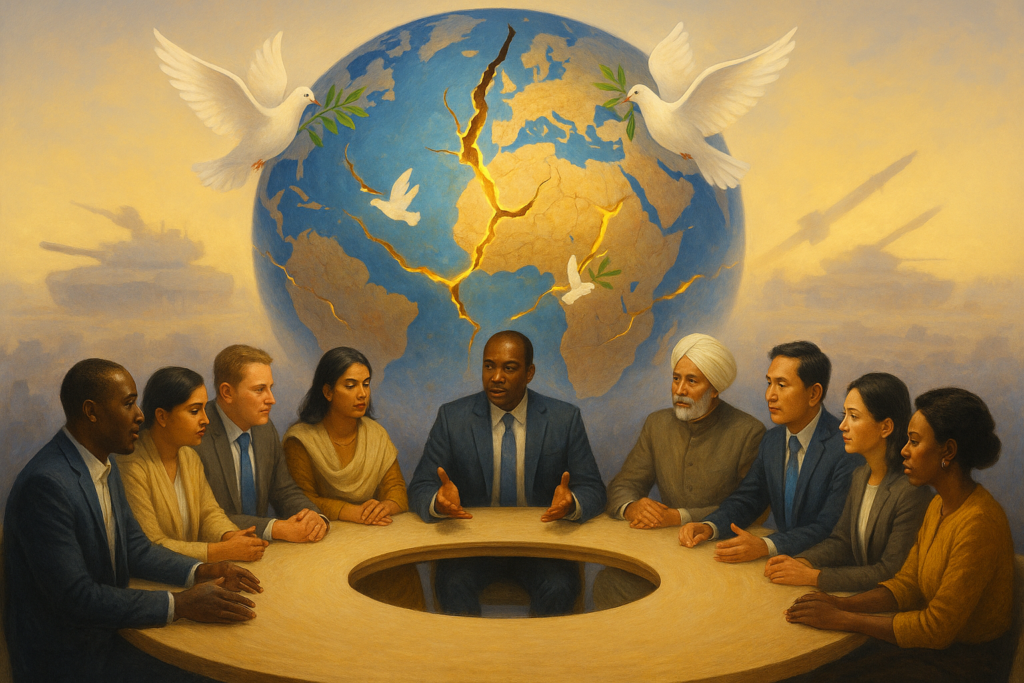
- The world has experienced the highest number of 59 conflicts (2024), with military spending reaching US$2.2 trillion (2024), while it is predicted that 300 million people need humanitarian aid.
- Acknowledgement of love, conscience, compassion, and a culture of peace and hope for humankind demonstrates the relevance of holding on to these eternal human values at this ‘moment of truth’ for the planetary future.
- It would be the greatest service to humanity if outstanding, conscientious scholars rose to the occasion to provide solutions that bring an end to global conflicts.
- In order to become a “global solution provider”, including “saying no to war”, we need to make timely investments in an architecture of Diplomatic Universities led by visionary global thought leaders.
On September 21, 2025, the International Day of Peace (vide UN General Assembly (UNGA) resolution 55/282 of September 7, 2001; mooted vide resolution 36/67 of November 30, 1981) came amidst a pall of gloom as numerous wars and armed conflicts were raging around the world. In his anguished message (September 21, 2025), the United Nations Secretary-General (UNSG) Antonio Guterres said, “our warring world is crying out for peace” as humankind’s hopes can materialise only in peace. “Lives are being ripped apart, childhoods extinguished, and basic human dignity discarded, amidst the cruelty and degradations of war. All they want is peace,” the UNSG said. It is no wonder that the feisty UNSG regards (September 22, 2025) “peace is the most courageous, the most practical, the most necessary pursuit of all.”
The advent of the year 2025 was expected to usher our troubled world into an era of hope and compassion for humankind. The UNGA resolution 79 (270) of March 04, 2025, affixed July 12 as the International Day of Hope and emphasised “the relevance of hope and well-being as universal goals and aspirations in the lives of human beings around the world”. This resolution builds upon the previous UNGA resolution 73/329 of 25 July 2019 that called for promoting the “Culture of Peace with Love and Conscience”.
Touching the Conscience of the Nations
The above emphatic acknowledgement and recognition, in a multilateral forum of the United Nations, of love, conscience, compassion, culture of peace and hope for humankind, shows relevance of holding on to these eternal human values at this “moment of truth” for the planetary future (SIS Blog; June 30, 2024). Notwithstanding how nations behave (through acts of omission and commission) and posturing of the high-level UN representatives and their political leaders in power, especially reflected in voting and speeches in the UN’s principal organs, the challenge of grappling with contemporary global conflicts and other issues would require a well calibrated nudge to the human urge for love, empathy, peace and conscience premised on the bedrock of hope for our common future. It is significant that the January 24, 2025, report of one of the ‘specialised agencies’ of the UN, the World Health Organisation, has been aptly titled with the word “compassion” that is “wired in the human brain” and arises from the universal experience of “shared humanity”. In the wake of making multilateralism work in the Digital Age, through the instrumentality of global conferencing technique (as witnessed in 2024, 2023, 2022), it would still require holding on to the conscience of humanity. To give effect to the Pact for the Future (UNGA resolution 79/1 of September 22, 2024), the outcome document of the 2024 Summit of the Future has called for walking the talk by appealing to the vibrations of the heart.
Invoking Tools of Dialogue and Diplomacy
The time-tested tools of “dialogue and diplomacy” are at the basis of the peaceful settlement of international disputes (Parts VI and VII of the 1945 UN Charter). The UNSG has repeatedly (2025, here; 2025, here; 2025, here; 2025, here) called for dialogue in various global conflicts to “silence guns, heal divisions and build hope”. In the UNSC debates, both permanent and non-permanent members prima facie speak in favour of recourse to talks among the warring factions in all the armed conflicts. Among assertions for peace by Heads of Government in the Global South, the Indian Prime Minister Modi is prominent in calling for “dialogue and diplomacy” in addresses at the global forums (2025, here; 2024, here; 2024, here; 2023, here; 2023, here) wherein he has underscored that “the future lies not in war, but in Buddha.”
The ongoing brutal violence in two major wars (Ukraine, Gaza), as well as recurring violence in other conflict zones, reflects the gravity of global threats posed by them. The regional and country issues [Africa (29); Americas (4); Asia (10); Europe (7); Middle East (8)] that remain listed on the UN Security Council’s seized items speak volumes about the challenges faced by the UN when it started (September 22, 2025), celebrating its 80th anniversary. The 1945 UN Charter will attain 80 years on October 24, 2025 (entry into force. Ironically, at this historic milestone, the resources across the UN system have shrunk by 30 per cent (compared to 2023). Its adverse effect is expected to be on the UN’s eleven peacekeeping operations: Western Sahara; Golan; Abyie; India and Pakistan; Central African Republic; Cyprus; Kosovo; Middle East; DR Congo; Lebanon; South Sudan (SIS Blog, Sept 18, 2024).
The Global Inflexion Point
The question of Legal Controls of International Conflicts (here, here), a course taught for many years by this author, has remained a scholarly quest for the elimination of the scourge of war that has been considered to be ‘extra-legal’ – neither legal nor illegal. There have been persistent global efforts for the ‘outlawry’ of warfare as seen in the 1907 Hague Peace Conferences, 1919 Treaty of Versailles and 1928 Pact of Paris. After the advent of the 1945 UN Charter, notwithstanding the ‘blueprint’ for the prohibition of war [Article 2 (4); Article 51], it has not been possible to banish wars. In 2018, the Nobel Peace Prize was awarded to Denis Mukwege and Nadia Murad, “for their efforts to end the use of sexual violence as a weapon of war and armed conflict”. Growing weaponisation of sexual & gender-based violence (Author: SGBV in International Law (2022; 2023) has become the biggest menace in all the global conflicts. “If we want people to say ‘no more war’, we have to show how brutal it is”, Berit Reiss-Andersen, Chair of the Norwegian Nobel Committee, said. Even way back in 1942, in the context of the Second World War, Mahatma Gandhi had called for imbibing the no-war mantra since: “The warring nations are destroying themselves with such fury and ferocity that the end will be mutual exhaustion. The victor will share the fate that awaited the surviving (victorious) Pandavas”. Historically, wars have been regarded as an appalling evil.
The world has experienced the highest number of 59 conflicts (2024), with military spending reaching US$2.2 trillion (2024), and the Global Humanitarian Overview (2024) predicts 300 million people in need of humanitarian aid. As per UN Women estimates of 2024, 6oo million women and girls (300 million in 2017) faced risks of violence in armed conflicts. In a worrisome 2025 UNICEF Global Outlook, armed conflicts also pose serious risks to over 473 million children living amidst conflicts. It is a cause of great concern that in the third decade of the 21st century, some 2 billion people live in global conflict zones.
Emerging from the ashes of the Second World War and the fall of the League of Nations, the UN Charter (adopted June 26, 1945) ushered humankind “to find a way to end wars”. The US President Harry Truman had expressed thanks to the Almighty God to “search for peace through world organisation”. “If we had had this Charter a few years ago, and above all, the will to use it–millions now dead would be alive. If we should falter in the future in our will to use it, millions now living will surely die”, Truman prophesied in the closing address at UNCIO in San Francisco. Yet, within 41 days, the same President Truman ordered the first dropping of the two nuclear bombs on the Japanese cities of Hiroshima (August 6) and Nagasaki (August 9). It killed between 150,000 and 246,000 people. That ghastly violence inflicted the first major blow to the Charter blueprint wherein all member states are required to “refrain in their international relations from the threat or use of force” [Article 2 (4)]. In its 80th year, the UN is struggling hard to douse all raging wars and armed conflicts, even as the UN Security Council often fails to adopt even ceasefire resolutions (UNSC 10000th meeting; 14 to 1 (US veto) vote on Gaza Strip; September 18, 2025).
Road Ahead
Since the seeds of warfare lie in the human mind, complete elimination remains a utopian goal. How to give effect to the assertion that “this is not an era of war”? (Indian PM; Sep 16, 2022). What will it take to bring about sanity among the warring groups driven by greed for power, past baggage, control over resources, proxy wars and sheer banality? It would be the biggest service to humanity if outstanding conscientious scholars rose to the occasion to provide “solutions” to bring an end to the global conflicts (SIS Blog: March 22, 2024; October 01, 2022). The tools of ‘dialogue and diplomacy’, driven by ideas for concrete solutions that are based on the bedrock of International Law, could include negotiations, good offices and mediation. It would yield ‘peace dividends’. Hence, it calls for entrusting the task to resolute trouble shooters, duly backed by a university-based scholarly architecture to provide cutting-edge conflict-specific solution-oriented research. In order to become a “global solution provider” (here, here, here) – including “saying no to war” (SIS Blog: Jan. 23, 2025) – we need to make timely investment in an architecture of Diplomatic Universities led by visionary global thought leaders.
******
Prof. Dr. Bharat H. Desai is a Humboldt Award Professor at the University of Bonn, Germany, and serves as the Editor-in-Chief of Environmental Policy and Law, Amsterdam, The Netherlands. He was formerly the Chairperson and Professor of International Law at the School of International Studies, Jawaharlal Nehru University, India.
